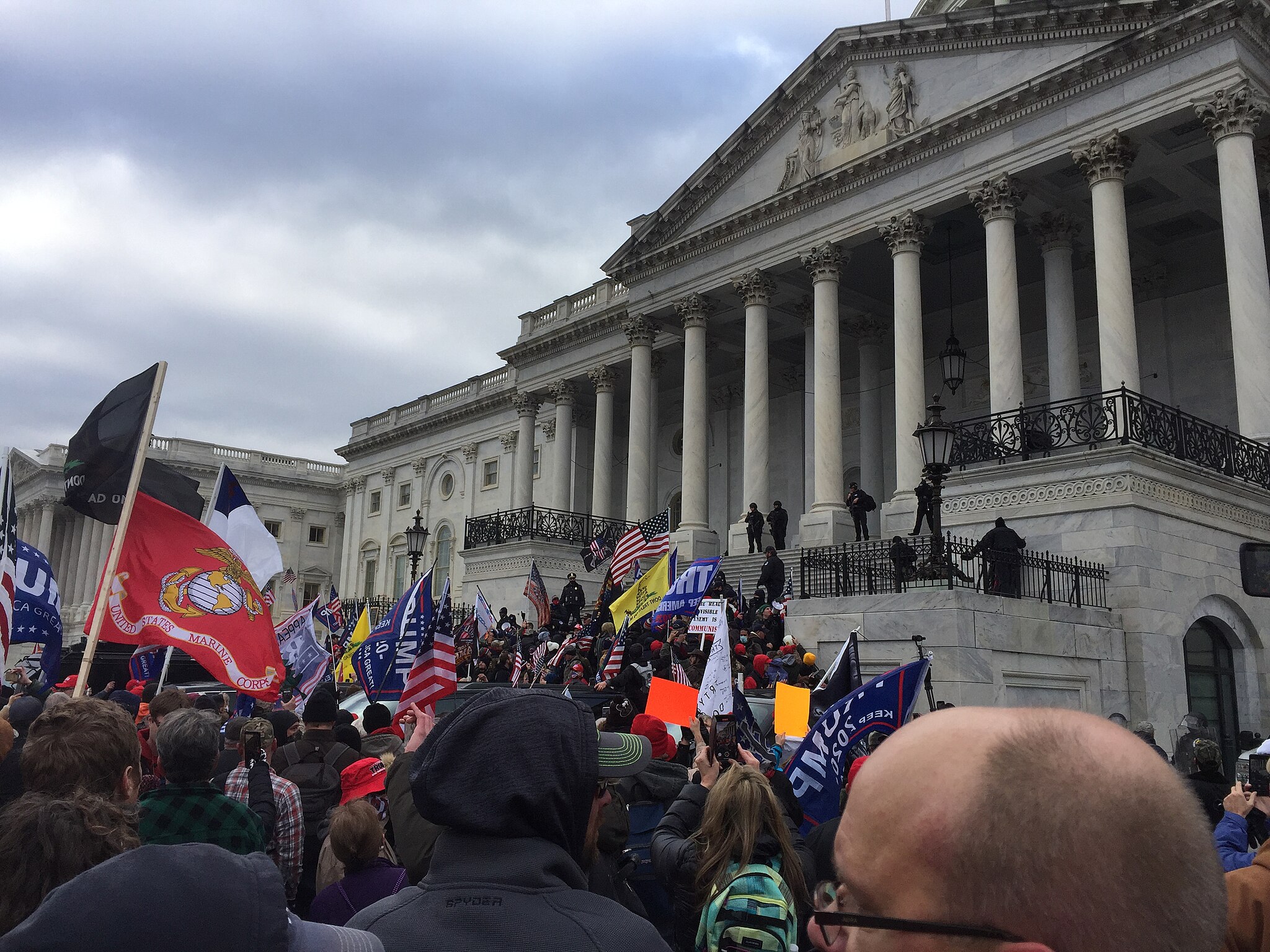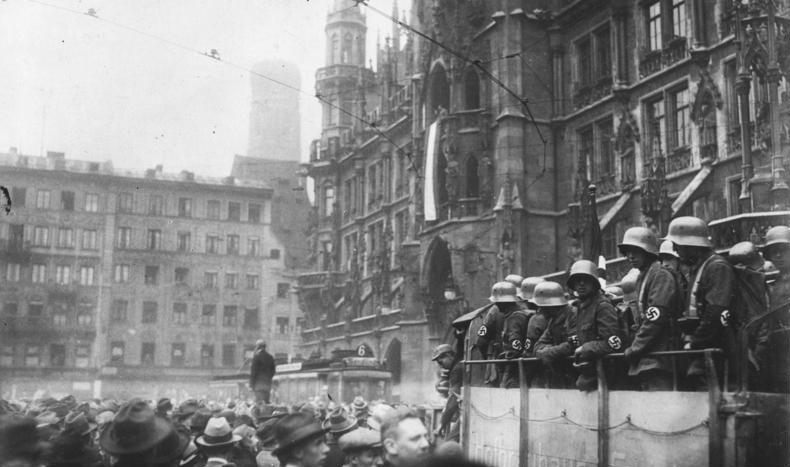Your cart is currently empty!
A Failed Coup D’état Leads to a Successful One

Summary: The Nazis attempted a coup d’état in 1923, and ten years later, Hitler was sworn into office. Within a year he would consolidate power to the Nazi party and himself, and strip citizens of many of their civil rights. The story is eerily similar to that of the right-wing Trump supporters who stormed the capital on January 6th, 2021.
On November 8th, 1923, about 2,000 Nazi Brown Shirts (Sturmabteilung, or SA) attempted to overthrow Germany’s Weimar Republic government and take control; it was a failed coup d’etat. The Brown Shirts were not taken seriously in the early twenties, some Germans even thought of them as a joke, and the Nazis were a fringe far-right extremist group with little support at first.
Germany’s economy fell after the end of World War I, and many citizens, like the Nazis, wanted governmental reforms and economic relief. When there is civil unrest in a country, especially a divided country, extremist and nationalist groups rise. Individuals like Adolf Hitler rose to prominence in politics, and they soon began planning acts of terror and violence.
Hitler’s sudden rise in popularity was due to charisma, public speaking skills, and being in the right place at the right time. He began speaking in the beer halls where people gathered and talked about society and politics, and people noticed his potential. Early Nazis like Anton Drexler helped prop Hitler up, he was the chairman in the German Workers’ Party (DAP), the predecessor to the Nazi Party. Extremism rose in Germany, and Hitler changed the DAP’s name to the Deutsche Nationalsozialistische Arbeiterpartei, the Nazi party.
The 1923 coup, or the Munich Beer Hall Putsch, was a planned act of political violence that ended in the deaths of 15 Nazis, 4 police officers, and 1 civilian bystander. They had planned to seize control of the government in the state of Bavaria, then march to Berlin to overthrow the rest of the Weimar Republic. The insurrection failed in a series of bloopers.

The Munich Marienplatz during the failed Beer Hall Putsch, 1923, CC-BY-SA 3.0 via the German Federal Archives and Wikimedia Commons
Adolf Hitler was spirited away to a safe house, and he was later arrested and charged with high treason. He served less than one year of his five-year prison sentence. His popularity rose during the trial, he received fan mail while in prison, and he dictated his political manifesto and autobiography Mein Kampf (1925) to his deputy.
Ten years after the attempted coup, Hitler ran for the German presidential election in 1932, and came in second to Paul von Hindenburg, who secured his second term as president. He was appointed to Chancellor to curb his power in January 1933, but it only made him more powerful. The Nazis became the second largest party in the Reichstag by the 1930s, just ten years after they began as an extremist group with little popularity.
He consolidated power to the Nazi party through political purges soon after that and got President Paul von Hindenburg to grant Hitler emergency powers. A few months later, von Hindenburg died, giving Hitler complete control.
The insurrectionists of January 6, 2021, at the United States Capitol resembled those of the Beer Hall Putsch; some of the Trump supporters there even identify themselves as Neo-Nazis or otherwise far right extremists. The Unite the Right rallies of 2017 and 2018, also paralleled Nazi rallies. They burned swastikas, held their hand up in a heil Hitler, and waved Nazi flags while shouting slogans such as, “The Jews will not replace us!” The far right as been rising rapidly in the United States, and many of them feel emboldened to express their bigotry more openly than ever before.
Insurrectionists were made up of groups such as the Proud Boys, Oath Keepers, Three Percenters, Qanon, Neo-Confederates, Neo-Nazis, and various other white supremacist and fascist groups which pose dire threats to the United States. They hold many of the same beliefs as the original Nazis revolving around racial segregation and conservative political values.

Photo by Alisdare Hickson, CC-BY SA, via Flickr.
Estimates of attendance at the January 6 rally go up to 80,000, several thousand of which participated in the violence when they stormed the Capitol. They had built gallows, chanted that people would die, and intended to overthrow the democracy of the United States to keep President Trump in office.
Six people died because of the January 6 riot, at least 174 police officers were assaulted, property was damaged or stolen, Donald Trump was impeached for a second time because of it, and he faced extensive legal repercussions for years.
One week before the 2024 election, Trump supporters rallied in Madison Square Garden. Racist remarks were said and democrats like Hillary Clinton and Tim Walz, among others, said that the gathering mirrored the Nazi rally held in the same venue in 1939. Trump and his supporters vehemently deny being Nazis, or even Nazi-like.
Throughout the Biden administration, 2021-2025, Trump supporters sang that he would “take America back,” and organized themselves to be ready. When Trump was announced as the winner of the recent United States election in November 2024, the right cheered in triumph.
They began letting their racism and misogyny fly, quickly coining “your body, my choice,” indicating that they would be controlling women’s bodies, and sending racist texts to Black folk across America threatening to enslave them in Trump’s American.
Many people in Germany and Austria did not see the danger that Hitler posed to them, they did not take their extreme beliefs at face-value, and they thought that the Brown Shirts were a joke. Not long after Trump declared his victory, Germany announced that their government would collapse, some believe it is directly tied to Trump’s win.
Share Your Perspective
Subscribe to Truthlytics today to stay informed and dive deeper into the issues that matter.
Already subscribed? Log in to join the conversation and share your thoughts in the comments below!




